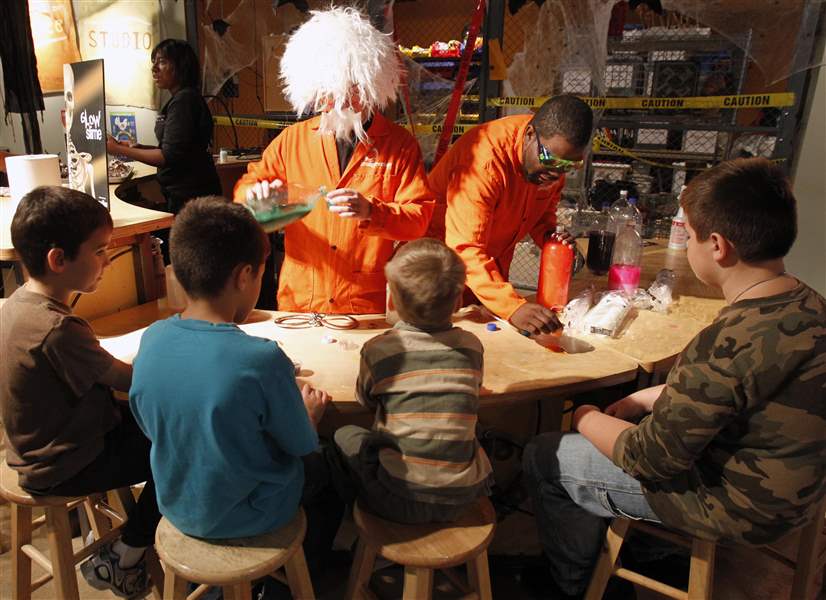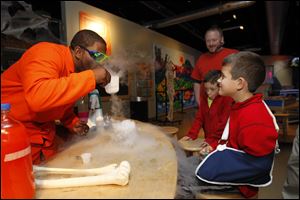
When it comes to spooky science, the eyes have it
10/23/2011
Mad scientist Joseph Brinkman, left, and Jason Pope help young visitors to Toledo's Imagination Station make slime during the first of two Spooky Science weekends at the downtown science center.
The Blade/Lori King
Buy This Image

Mad scientist Joseph Brinkman, left, and Jason Pope help young visitors to Toledo's Imagination Station make slime during the first of two Spooky Science weekends at the downtown science center.
Forget the bowl of peeled grapes that gets passed off as eyeballs at Halloween parties.
At the Imagination Station Saturday, real cow eyeballs were plunked on plastic cafeteria trays for visitors -- wearing safety glasses and gloves -- to dissect.
"This is going to be awesome!" 9-year-old Joe Hammersmith exclaimed when his big blue cow's eye arrived.
IF YOU GO
What: Spooky Science
Where: Imagination Station, at Summit and Adams streets in downtown Toledo
When: Noon to 5 p.m. today and Oct. 30, 10 a.m. to 5 p.m. Oct. 29.
Admission: $9 for adults (13 and older), $8 for seniors (65 and older), $7 for children (3-12), and free for members and children under 2.
Information: 419-244-2674 or imaginationstationtoledo.org.
His enthusiasm didn't wane as Imagination Station floor team associates Kristen Johnson and DeJaunteye Hawkins led the young scientists through the dissection.
That was one of the many Spooky Science activities planned this weekend and next to get visitors to the downtown science center into the Halloween spirit.
Young Hammersmith, of Buffalo, was with his family and the friends they were visiting in Findlay.
He used scissors to cut the optic nerve and remove fat and tissue from around the cow's eye.
After Ms. Johnson cut a slit into the right side of each cornea with a scalpel, she coached her students to flip over the eyeball and gently squeeze the fluid out of it.
"Oh, this is awesome," Joe said as fluid dribbled onto his tray.

Jason Pope sets the mood for all things Halloween by creating smoke for 9-year-old Findlay brothers Ben, wearing a sling, and Nate Garcia. Watching the experiment with dry ice was their uncle, Jim Price of Pittsburgh.
Next, he and the others used scissors to cut all the way around the eyeball to reveal the contents inside -- the "jelly stuff" called vitreous humor that helps the eye maintain its shape ("It looks like Jell-O," Joe remarked) and a little ball that was actually the lens.
"That is so darn neat," Joe said, after retrieving his lens from the floor.
He turned the cornea inside out, peeled off the iris, scooped out the retina, and discovered an iridescent coating behind all that called the tapetum.
"Unfortunately, this is not located in our eye," Ms. Johnson explained.
"It's found in cow's eyes, deer eyes, and cat eyes. It helps them see at night."
Cow's eye dissections will resume at 2 p.m. and 4 p.m. today and Saturday and Sunday. At 3:30 p.m. each weekend day, "the Doctor" and his assistant, Igor, will give live demonstrations in the laboratory, attempting to re-animate objects.
And throughout each of the Spooky Science days, visitors can taste edible blood, make their own slime, create spider webs, get a fake bloody wound, and discover "boo bubbles."
"Do we get to hold it?" 6-year-old Ashley Cutcher of Toledo asked after shaking up a cup of bubble gum pink-colored slime.
With an OK from an adult, she plopped it into her palm and found it sticky.
Eight-year-old Lukas Tilley-Estep described the boo bubbles as "an experiment with dry ice."
The dry ice reacted with warm water, and, when mixed with soap, it formed a bubble that -- pop! -- turned into that eerie kind of smoke that's really carbon dioxide gas.
Carl Nelson, chief scientist at the Imagination Station, said the process demonstrates sublimation -- a change in the state of matter from solid to gas that skips right over the liquid phase.
"The nice thing is, it's very, very visual, very captivating. You can get their attention," Mr. Nelson said, adding that getting kids interested in science is what the Imagination Station is all about.
Sponsored by Meijer, all of the Spooky Science activities are included in the cost of admission.